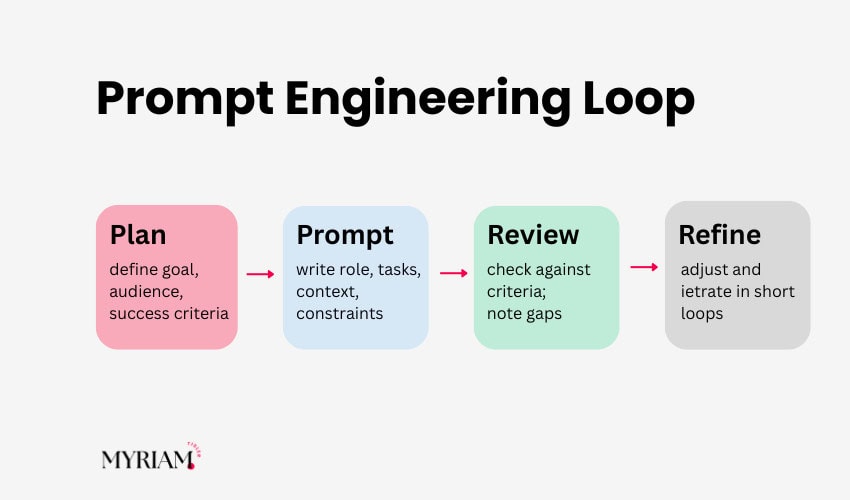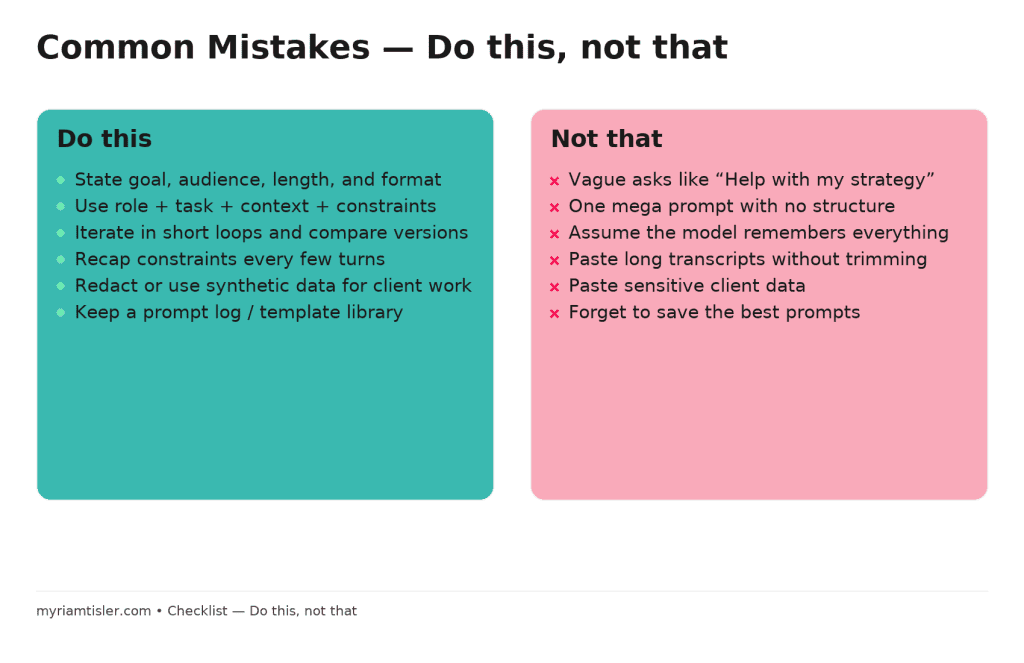Prompt engineering is the skill of writing clear, structured instructions that guide AI models to produce useful, reliable outputs. In this guide, you’ll learn what it is, why it matters in 2025, how to apply it safely, and it gives practical examples, a two-track cheat sheet, and FAQs for quick reference.
What Is Prompt Engineering?
Prompt engineering is the practice of designing and refining instructions that steer large language models (LLMs) toward the result you want. Good prompts frame role, task, context, constraints, and output format, so the model can follow your intent. Industry guides, such as Google Cloud’s prompt engineering guide and Anthropic’s prompt engineering overview, describe this as an iterative craft of clear instructions, worked examples, and a stepwise structure.
New to AI concepts? Start with this plain-English overview of the types of AI.
Why it surged in 2023 – 2025
General-purpose LLMs became capable enough for everyday work, yet still sensitive to how you ask. Getting value is less about code and more about structured communication. Microsoft’s Learn’s prompt engineering techniques make the same point: behaviour is highly prompt-sensitive, so construction is a key skill.
Why Is Prompt Engineering Important?
In plain English: better prompts mean better outputs, fewer rewrites, and faster workflows. Clear constraints reduce meandering answers. Good structure turns a vague “help me” into a crisp, repeatable process. Both Google Cloud’s prompt engineering guide and Microsoft’s prompt engineering techniques stress that explicit instructions, examples, and iteration materially improve quality.
For a bigger picture of how AI is reshaping work, here are 51 ways AI changes the workplace.
Data-backed impact (2024–2025)
- Adoption is mainstream. McKinsey’s latest global survey reports 78% of organisations now use AI in at least one business function, with the biggest value emerging where workflows are redesigned around AI rather than bolted on. See McKinsey’s State of AI.
- Measured productivity gains. In controlled writing tasks, access to ChatGPT made work roughly 37–40% faster while improving output quality. (see MIT’s experimental study). In real customer-support operations, a generative AI assistant raised agent productivity by ~14–15%, with the largest gains for less-experienced staff (see NBER working paper and the peer-reviewed QJE article).
Who benefits and how
- Consultants: accelerate discovery, research, and drafting client deliverables without reinventing the wheel each time.
- Startups & Solopreneurs: ship faster, keep costs down, and punch above your weight with small-team automation.
Note for enterprise readers (callout)
Never paste sensitive client data into an LLM. Use anonymised, redacted, or synthetic inputs. Work at a summarised, pattern level and maintain an audit trail. This aligns with the NIST AI Risk Management Framework and its Generative AI Profile.
If you work with client data
- Anonymise by default: replace names and identifiers with placeholders like [ROLE], [ORG], [ID].
- Work at altitude: summarise themes and decisions rather than pasting transcripts or contracts.
- Synthetic-first: practice and template with realistic, fictitious data.
· Leave a trail: store prompts and outputs in a project repo for review. For UK work, the ICO’s guidance on AI and data protection is a solid reference.
| Version | Prompt | Typical Output |
|---|---|---|
| Weak | “Summarise this.” | Generic, misses context and audience. |
| Strong | “Act as a PM. Summarise the five key decisions, open risks, and next steps from the anonymised notes below for a senior stakeholder update. Keep to 120 words.” | Focused bullets aligned to the audience and format. |
Core Principles of Prompt Engineering
- Clarity and specificity — state the goal, audience, scope, and success criteria.
- Role assignment — “Act as a… [analyst/coach/QA reviewer]” to set perspective.
- Step-by-step structure — ask for numbered steps or sections; it reduces drift.
- Constraints — define tone, length, format, and any must-include items.
- Iteration — review, refine, and re-prompt in small cycles; Google Cloud’s prompt engineering guide emphasises iteration as core to quality.
Prompt patterns that matter in 2025 (plain-English)
- Few-shot examples: show the model short examples of “what good looks like” before asking it to generalise (see Google’s introduction to prompt design).
- Self-consistency: generate multiple candidates and select the consensus for reasoning tasks (research: Self-Consistency Improves Chain-of-Thought).
- ReAct: alternate between reasoning (“think”) and using tools or search (“act”) to solve tasks (paper: ReAct: Synergizing Reasoning and Acting).
Tree-of-Thoughts: explore several solution paths, evaluate them, then pick the best (paper: Tree of Thoughts: Deliberate Problem Solving).

How LLMs Handle Context (Tokens & Windows)
LLMs don’t “remember” indefinitely. They read a rolling window of text measured in tokens. As a rule of thumb for English, 100 tokens ≈ 75 words. When your chat exceeds the model’s context window, earlier details drop out, hence why long threads drift. For the basics, see OpenAI’s primer on tokens.
Context windows are getting larger, but concise prompts and periodic recaps still deliver the most consistent results. Recent Claude models, for example, advertise very large contexts; see Anthropic’s model overview for current context window specs.
Practical rule: if a thread changes scope, start a new chat and restate the brief (role, task, constraints).
Practical tips
- Recap constraints and success criteria every few turns.
- Start a fresh thread for each project or major task.
- Trim pasted text; keep just what the model needs.
Prompt Engineering Examples for Consultants & Startups
To keep this practical and scannable, examples are grouped by use case.
For Startups & Solopreneurs
Marketing and content
- Product description generator
“Act as a conversion copywriter. Write a 120-word product description for a [product] aimed at [audience]. Emphasise [benefit 1] and [benefit 2]. Output: headline, 3 bullets, short paragraph.” - Website copy outline
“Create an outline for a Services page for [niche]. Include sections, suggested H2/H3s, and a one-line value proposition per section.” - Landing-page wireframe
“Draft a landing-page section order for [offer]: hero, social proof, benefits, how it works, pricing, FAQs. Add a one-line conversion tip per section.” - Social post variations
“Turn this paragraph into 3 platform-specific posts for X, LinkedIn, and Instagram. Keep each within typical limits and add one relevant hashtag.”
Customer support
- Reply drafts from a knowledge base summary
“Act as a support agent. Using the summary below, write a polite reply that recognizes the customer’s issue, lists two troubleshooting steps, and offers a next action. Keep to 120 words. Summary: [paste KB summary].”
Admin and ops (keep light)
- SOP outline
“Draft a short SOP for [task] with purpose, prerequisites, steps, and QA checks.” - Invoice or Proposal email skeleton
“Write a friendly template for a proposal hand-off email with sections: purpose, deliverables, timeline, call-to-action.”
If you’re systemising delivery, these AI project management tools can help with planning and status updates.
| Before | After |
|---|---|
| “Write a product description.” | “Act as an e-commerce copywriter. Write a 120-word description for [audience], highlight [2 benefits], include a power headline, and a 3-bullet feature list. Avoid jargon.” |
For Consultants (enterprise-safe patterns)
Market research and prep work (safe pre-contract prompts)
- Sector primer
“Create a two-paragraph primer on the [sector] value chain, typical revenue drivers, and current pressures. Include one credible source to read next.” - Competitor snapshot
“Summarise [competitor] in 120 words: product focus, differentiators, pricing posture, and notable partnerships. Provide 1 reputable source.” - Regulatory landscape overview
“Outline the regulatory considerations for [domain] in [region]. Structure as bullets with links to primary guidance.”
If you’re assessing maturity and governance, read my guide to operational readiness for AI.
Client deliverables (with redaction pre-step)
- Redaction pre-step
“You are a secure redactor. Replace any names, organisations, locations, IDs, or dates with placeholders like [ROLE], [ORG], [CITY], [ID], [DATE]. Return only the redacted text.” - Stakeholder interview synthesis (from anonymised notes)
“Act as a business analyst. Using the anonymised notes, extract: 1) five themes, 2) decisions made, 3) open risks, 4) next steps. Output as bullets for an executive reader.” - Process map step list (neutral labels)
“Create a BPMN-style step list for a generic Quote-to-Cash process. Include swimlanes for Sales, Ops, and Finance, list hand-offs, and note three common failure modes.” - Measurement mini-template
“Define success criteria for this prompt: target audience, word limit, mandatory sections, and 1 measurable acceptance test. Then produce the draft.”
Running the business (light admin)
- Time entry summary
“Summarise this week’s time entries into a client-facing update with workstreams, achievements, and planned next steps.” - Expense claim checklist
“Create a checklist for monthly expense claims with categories, required evidence, and common pitfalls.”
On a recent discovery phase, I saved several hours by combining the redaction pre-step with a structured synthesis prompt. I worked only with anonymised, high-level notes, produced an executive-friendly summary, and kept a prompt log so the client could review the approach later. That balance of speed with rigour is the point.
Common Mistakes to Avoid
- Vague asks: “Help with my strategy” invites meandering. State goal, audience, length, and format.
- One-shot thinking: big tasks improve through iteration. Ask for versions, compare them, and then refine.
- Forgetting the audience: change the role, tone, and vocabulary to match who will read it.
- Assuming the model remembers: chats have context limits; recap constraints every few turns, and start a fresh thread for new projects. For a quick primer on how token limits work, see OpenAI’s guide to tokens and context windows
- Pasting sensitive data: treat LLMs as external unless you have explicit approval. Redact or synthesize first and align with recognized frameworks like the NIST AI Risk Management Framework and the companion Generative AI Profile.
- Assume external by default: unless your org has a vetted, private deployment, treat public LLMs as external services and redact or synthesise first.
- Not documenting prompts: you lose hard-won patterns. Keep a simple prompt log or template library.

Measure Quality & Add Guardrails
Prompts become assets when they are testable and governed.
How to test quickly
- Define success criteria up front: audience, must-include items, length, and format.
- Keep test cases to compare versions.
Review against the criteria, then refine. This mirrors Anthropic’s guidance on defining success and building evaluations used in enterprise prompting.
Lightweight guardrails
· Align practice with the NIST AI Risk Management Framework and the companion Generative AI Profile.
· For UK work, skim the ICO’s guidance on AI and data protection and its consultations to understand regulator expectations.
Next-step topics to explore briefly (optional)
· Retrieval-Augmented Generation (RAG): bring verified documents into context for factual tasks and fewer hallucinations – see Retrieval-Augmented Generation for Knowledge-Intensive NLP.
· Agents: orchestrate multi-step tool use and actions; a good overview is A Survey on LLM-based Agents.
· Advanced patterns: Self-Consistency, ReAct, and Tree-of-Thoughts are helpful to know, but not required for day-to-day business writing.
If you’re exploring agents, think of them as multi-step prompts with tools: break tasks into roles, chain decisions, and log each step for review.
Bonus: Prompt Engineering Cheat Sheet
Quick-reference structure
- Role: who the model should be.
- Task: what to produce.
- Context: background, audience, domain.
- Constraints: tone, length, format, and must-include items.
- Output: bullets, table, JSON, slide outline, etc.
- Review loop: “Give me 2 variants and one improvement suggestion.”
Two-track layout
Standard Mode (startups & solopreneurs)
- “Act as a conversion copywriter. Write a 120-word product description for [product] aimed at [audience]. Use a benefit-led headline and 3 bullets. Avoid jargon.”
- “You are a support agent. Draft a concise reply that acknowledges the issue, lists two steps, and signs off warmly. Keep to 120 words.”
Enterprise Mode (consultants)
- “Act as a business analyst. Using anonymised notes, extract five themes, decisions, open risks, and next steps. Keep identifiers as [ROLE], [ORG], [DATE]. Output: 5 bullets + short RAID list.”
- “Produce a neutral Quote-to-Cash step list with swimlanes and three failure modes. Avoid client-specific labels.”
- Redaction pre-step to copy above your working prompt when needed.
Want structured practice? See my ChatGPT training picks for hands-on exercises and workflows.
FAQ: Prompt Engineering in Plain English
What is prompt engineering in AI?
It’s the practice of designing and refining instructions that guide an AI model to produce specific, useful results. Clear roles, context, constraints, and examples improve quality, and the process is iterative. For a concise overview, see Google Cloud’s prompt engineering explainer and Anthropic’s overview of prompt engineering.
How hard is it to learn prompt engineering?
It is learnable for non-technical people because it draws on communication skills. Most improvements come from being specific, showing examples, and refining in short loops rather than trying to get it perfect in one go. A good starting point is Google’s introduction to prompt design.
Do you need a course to get good at it?
While you can learn prompt engineering through free guides and structured practice, many solopreneurs and small businesses prefer a more guided path. If you’re evaluating whether a structured program is worth it, my https://myriamtisler.com/ai-for-business-course-review breaks down one of the most well-rounded options for learning how to apply AI in real business operations, including prompts, workflows, and practical use cases.
You can start with free guides and structured practice. A course can accelerate progress if you want curated techniques, feedback, and business-focused patterns.
Is prompt engineering dead?
No. Models improved, but results still depend on how you define role, context, constraints, and output format — especially for business-grade work.
Prompting vs prompt engineering – what’s the difference?
Prompt engineering is a repeatable method: role → task → context → constraints → output → review.
Final thoughts
You’ve seen what prompt engineering is, why it matters this year, and how to apply it with practical examples for both startups and consultants. Start small: pick two prompts from the cheat sheet, run them today, and save anything that works. Build a personal prompt library, iterate on it weekly, and keep a simple prompt log so that your best instructions are never lost.
Tip: If you want a formal credential, consider 101 Blockchains’ Certified Prompt Engineering Expert™.
Next steps: try two prompts now, subscribe for more templates, and explore deeper training if you want structured practice.
Need enterprise-safe help? Explore my process improvement & business analysis consulting.
Prompt engineering guide for consultants and startups: this plain-English summary covers core principles (role, task, context, constraints), grouped examples for solopreneurs and consultants, and a two-track cheat sheet (Standard vs Enterprise). It explains the plan → prompt → review → refine loop, why context windows matter, and the common mistakes to avoid. For privacy-safe practice, it points to the NIST AI Risk Management Framework and the ICO’s guidance on AI and data protection. Use it to level up marketing copy, support replies, research prep, stakeholder synthesis, and process mapping. Try two prompts, log what works, iterate weekly, and scale what proves effective.







